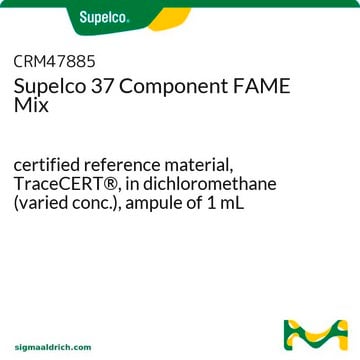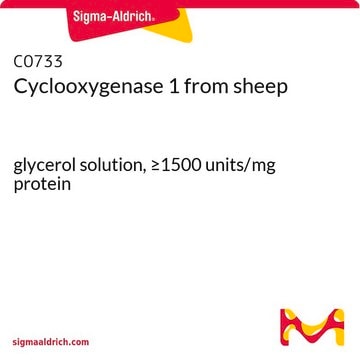Products may be shipped at a different temperature than the recommended long-term storage temperature. If the product quality is sensitive to short-term exposure to conditions other than the recommended long-term storage, it will be shipped on wet or dry-ice. If the product quality is NOT affected by short-term exposure to conditions other than the recommended long-term storage, it will be shipped at ambient temperature. As shipping routes are configured for minimum transit times, shipping at ambient temperature helps control shipping costs for our customers. For more information, please refer to the Storage and Transport Conditions document: https://www.sigmaaldrich.com/deepweb/assets/sigmaaldrich/marketing/global/documents/316/622/storage-transport-conditions-mk.pdf
Kluczowe dokumenty
A3611
Arachidonic acid
from non-animal source, ≥98.5% (GC)
Synonim(y):
cis,cis,cis,cis-5,8,11,14-Eicosatetraenoic acid, Eicosa-5Z,8Z,11Z,14Z-tetraenoic acid, Immunocytophyte
Wybierz wielkość
478,00 zł
Wybierz wielkość
About This Item
478,00 zł
Polecane produkty
pochodzenie biologiczne
non-animal source
Poziom jakości
Próba
≥98.5% (GC)
Formularz
liquid
współczynnik refrakcji
n20/D 1.4872 (lit.)
bp
169-171 °C/0.15 mmHg (lit.)
mp
−49 °C (lit.)
gęstość
0.922 g/mL at 25 °C (lit.)
grupa funkcyjna
carboxylic acid
typ lipidu
omega FAs
Warunki transportu
dry ice
temp. przechowywania
−20°C
ciąg SMILES
OC(CCC/C=C\C/C=C\C/C=C\C/C=C\CCCCC)=O
InChI
1S/C20H32O2/c1-2-3-4-5-6-7-8-9-10-11-12-13-14-15-16-17-18-19-20(21)22/h6-7,9-10,12-13,15-16H,2-5,8,11,14,17-19H2,1H3,(H,21,22)/b7-6-,10-9-,13-12-,16-15-
Klucz InChI
YZXBAPSDXZZRGB-DOFZRALJSA-N
Szukasz podobnych produktów? Odwiedź Przewodnik dotyczący porównywania produktów
Powiązane kategorie
Zastosowanie
<li><strong>Molekularne mechanizmy związane z hamującą rolą długołańcuchowych n-3 PUFA w raku jelita grubego:</strong> Niniejsze badanie omawia wpływ długołańcuchowych wielonienasyconych kwasów tłuszczowych, takich jak kwas arachidonowy, na mechanizmy raka jelita grubego. Badania koncentrują się na roli przeciwzapalnej i hamującej raka poprzez modulację metabolizmu lipidów i szlaków transdukcji sygnału (Jayathilake et al., 2024).</li>
<li><strong>Zhilining Formula łagodzi zapalenie jelita grubego wywołane przez DSS poprzez hamowanie stanu zapalnego i dysfunkcji bariery jelitowej poprzez oś AHR/NF-Bp65:</strong> W artykule przedstawiono rolę kwasu arachidonowego w hamowaniu stanu zapalnego i przywracaniu funkcji bariery jelitowej, co ma kluczowe znaczenie dla zrozumienia chorób zapalnych i opracowania strategii terapeutycznych (Zhou et al., 2024).</li>
<li><strong>Lakton 5,6-diHETE (EPA-L) pośredniczy w nadciśnieniowym rozszerzeniu mikronaczyń poprzez aktywację śródbłonkowego szlaku sygnałowego GPR-PLC-IP(3):</strong> Bada konsekwencje sercowo-naczyniowe metabolitów kwasu arachidonowego, w szczególności ich rolę w reakcjach mikronaczyniowych, co może wpłynąć na strategie leczenia nadciśnienia (Asulin et al., 2024).</li>
</ul>.
Działania biochem./fizjol.
Opakowanie
Hasło ostrzegawcze
Warning
Zwroty wskazujące rodzaj zagrożenia
Zwroty wskazujące środki ostrożności
Klasyfikacja zagrożeń
Eye Irrit. 2 - Skin Irrit. 2
Kod klasy składowania
10 - Combustible liquids
Klasa zagrożenia wodnego (WGK)
WGK 3
Temperatura zapłonu (°F)
235.4 °F - closed cup
Temperatura zapłonu (°C)
113 °C - closed cup
Wybierz jedną z najnowszych wersji:
Certyfikaty analizy (CoA)
Nie widzisz odpowiedniej wersji?
Jeśli potrzebujesz konkretnej wersji, możesz wyszukać konkretny certyfikat według numeru partii lub serii.
Masz już ten produkt?
Dokumenty związane z niedawno zakupionymi produktami zostały zamieszczone w Bibliotece dokumentów.
Klienci oglądali również te produkty
-
How is shipping temperature determined? And how is it related to the product storage temperature?
1 answer-
Helpful?
-
-
How can I determine the shelf life / expiration / retest date of this product?
1 answer-
If this product has an expiration or retest date, it will be shown on the Certificate of Analysis (COA, CofA). If there is no retest or expiration date listed on the product's COA, we do not have suitable stability data to determine a shelf life. For these products, the only date on the COA will be the release date; a retest, expiration, or use-by-date will not be displayed.
For all products, we recommend handling per defined conditions as printed in our product literature and website product descriptions. We recommend that products should be routinely inspected by customers to ensure they perform as expected.
For products without retest or expiration dates, our standard warranty of 1 year from the date of shipment is applicable.
For more information, please refer to the Product Dating Information document: https://www.sigmaaldrich.com/deepweb/assets/sigmaaldrich/marketing/global/documents/449/386/product-dating-information-mk.pdfHelpful?
-
-
What is the solubility of item A3611, Arachidonic acid?
1 answer-
This product is soluble in DMSO (100 mg/ml), DMF (100 mg/ml), 100% ethanol (50 mg/ml), methanol (50 mg/ml), chloroform (50 mg/ml), dichloromethane, hexane, acetonitrile, and ether.
Helpful?
-
-
what is the volume in the 10mg ampule for A3611- arachidonic acid?
1 answer-
Based on the density of 0.922 g/mL, the volume of the 10 mg package is approximately 0.011mL.
Helpful?
-
-
What is the volume in microL of arachidonic acid (A3611-100 mg) in vial? Please specify the purity (PCode 1003455023).
1 answer-
There is 108 uL in the 100mG pack size. The exact purity will be listed on the Certificate of Analysis. Please see the sample Certificate of Analysis: https://www.sigmaaldrich.com/certificates/sapfs/PROD/sap/certificate_pdfs/COFA/Q14/A3611-1G-PWSLCQ3577.pdf
Helpful?
-
-
May I know the Molarity (M) of the Arachidonic Acid A3611? It was not stated in the SDS.
1 answer-
The concentration for this product will be lot specific as purity changes with each batch. The concentration of this material can be calculated by the following equation: density x 1000 x purity percent divided by the molecular weight. For example, lot SLCQ3577 on the sample certificate of analysis will have a concentration of about 3.01 M
Helpful?
-
-
Hi, I'm used to ordering AA with this same catalogue nr at 10mg in powder form. Now only 100mg in liquid form is available. In which solvent is this?
1 answer-
This is pure arachadonic acid - it is not in any solvent. Its melting point is at -49 deg C. At temperatures above, it will be in its liquid physical state. You can determine the amount by using the density for a calculation. 0.922 g/mL at 25 °C (lit.)
Helpful?
-
Active Filters
Nasz zespół naukowców ma doświadczenie we wszystkich obszarach badań, w tym w naukach przyrodniczych, materiałoznawstwie, syntezie chemicznej, chromatografii, analityce i wielu innych dziedzinach.
Skontaktuj się z zespołem ds. pomocy technicznej










